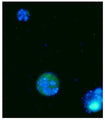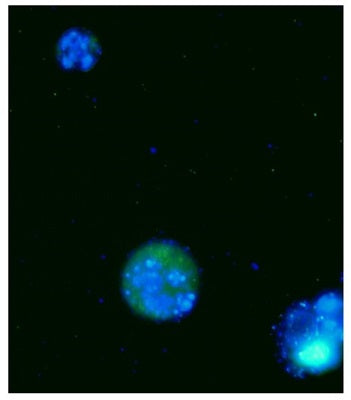Ships: 1-2 business days
- Prepare samples and controls
- Dilute 10X Apoptosis Wash Buffer 1:10 with diH20.
- Reconstitute FLICA with 50 µL DMSO.
- Dilute FLICA 1:5 by adding 200 µL PBS.
- Add diluted FLICA to each sample at 1:30 (e.g., add 10 µL to 290 µL of cultured cells).
- Incubate approximately 1 hour.
- Remove media and wash cells 3 times: add 1X Apoptosis Wash Buffer and spin cells.
- If desired, label with additional stains, such as Hoechst, Propidium Iodide, 7-AAD, or an antibody.
- If desired, fix cells.
- Analyze with a fluorescence microscope, fluorescence plate reader, or flow cytometer. FAM-FLICA excites at 492 nm and emits at 520 nm.
If working with adherent cells, please see the manual for additional protocols.
Kit 91: 25 Tests
FLICA Poly Caspase Reagent (FAM-VAD-FMK), 1 vial, #637
10X Apoptosis Wash Buffer, 15 mL, #635
Fixative, 6 mL, #636
Propidium Iodide, 1 mL, #638
Hoechst 33342, 1 mL, #639
Kit Manual
Kit 92: 100 Tests
FLICA Poly Caspase Reagent (FAM-VAD-FMK), 4 vials, #637
10X Apoptosis Wash Buffer, 60 mL, #634
Fixative, 6 mL, #636
Propidium Iodide, 1 mL, #638
Hoechst 33342, 1 mL, #639
Kit Manual
Product Specific References
| PMID | Publication |
| 39551802 | Xi, Y., et al. 2024. TSG101 depletion dysregulates mitochondria and PML NBs, triggering MAD2-overexpressing interphase cell death (MOID) through AIFM1-PML-DAXX pathway. Cell Death & Disease, 838. |
| 39450559 | Nanashima, N, et al. 2025. Silencing of ERRα gene represses cell proliferation and induces apoptosis in human skin fibroblasts. Molecular Medicine Reports, . |
| 39427529 | Żołnowska, B, et al. 2024. Novel benzenesulfonamide-aroylhydrazone conjugates as carbonic anhydrase inhibitors that induce MAPK/ERK-mediated cell cycle arrest and mitochondrial-associated apoptosis in MCF-7 breast cancer cells. Bioorganic & Medicinal Chemistry, 117958. |
| 39403371 | Forrer, P, et al. 2024. Unveiling signaling pathways inducing MHC class II expression in neutrophils. Frontiers in Immunology, 1444558. |
| 38927014 | Manzano, JAH, et al. 2024. Globospiramine Exhibits Inhibitory and Fungicidal Effects against Candida albicans via Apoptotic Mechanisms. Biomolecules, . |
| 38197946 | Peng, V., et al. 2024. Inositol phosphatase INPP4B sustains ILC1s and intratumoral NK cells through an AKT-driven pathway. The Journal of experimental medicine. |
| 38112058 | Costigan, A., et al. 2023. Discriminating Between Apoptosis, Necrosis, Necroptosis, and Ferroptosis by Microscopy and Flow Cytometry. Current protocols, e951. |
| 36896789 | Han, Z., et al. 2023. Irisin attenuates acute lung injury by suppressing the pyroptosis of alveolar macrophages. International journal of molecular medicine. |
| 37036426 | Yamada, T., et al. 2023. TIGIT mediates activation-induced cell death of ILC2s during chronic airway allergy. The Journal of experimental medicine. |
| 37603766 | Kroll, K.T., et al. 2023. Immune-infiltrated kidney organoid-on-chip model for assessing T cell bispecific antibodies. Proceedings of the National Academy of Sciences of the United States of America, e2305322120. |
| 36271147 | Wu, R., et al. 2022. Mechanisms of CD40-dependent cDC1 licensing beyond costimulation. Nature immunology. |
| 36499277 | von Amsberg, G., et al. 2022. Salvage Chemotherapy with Cisplatin, Ifosfamide, and Paclitaxel in Aggressive Variant of Metastatic Castration-Resistant Prostate Cancer. International Journal of Molecular Sciences, 14948. |









